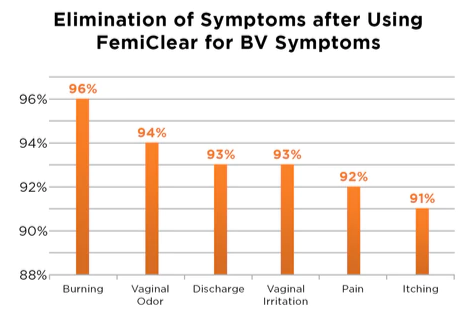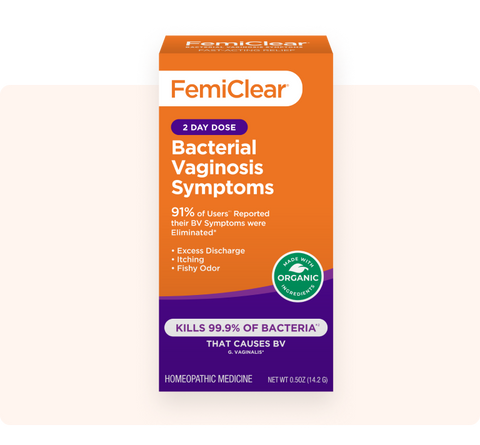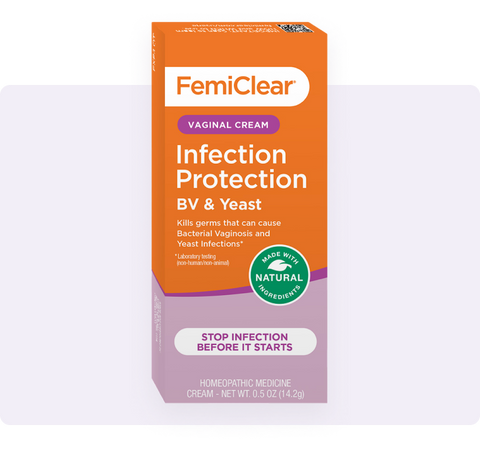Table of Contents
Related Articles
Boric Acid: What You Need to Know Before Using It for BV or Yeast Infections
Written by Jordan Liffengren May 23, 2025

This post was originally published in October 2023 and has been updated for comprehensiveness
If you’ve been dealing with recurrent bacterial vaginosis (BV) or yeast infections, it’s understandable that you’d be looking for anything that promises relief. Boric acid suppositories are often marketed as a natural remedy for vaginal infections—but it’s important to separate the facts from trends. Despite growing popularity, boric acid is not a proven treatment for BV or yeast infections symptoms, and its safety and effectiveness remain questionable.
Understanding The Cause of Bacterial Vaginosis
Bacterial vaginosis is the most common vaginal infection and is caused by an imbalance of bacteria in the vagina. Researchers only know that BV correlates with sex and the bacteria Gardnerella vaginalis. Other potential related bacteria include Lactobacillus, Prevotella, and Streptococcus viridans.
It’s estimated that up to 1 in 3 women will have BV in their lifetime. This infection is likely to recur, as research indicates that around 50% of women who have a BV infection will have a recurrent case of BV within six months of their initial diagnosis.
Common symptoms of BV include:
- Fishy Odor
- Elevated Vaginal pH
- Itching
- Burning while Urinating
- Thin, Greyish/White Discharge
Traditional remedies for BV include oral antibiotics, antibiotic suppositories, or boric acid suppositories.
What is Boric Acid?
Boric acid, also known as orthoboric acid, is a chemical compound made of boron, oxygen, and hydrogen. It’s found in a variety of industrial and household products, including pesticides, antiseptics, and glass and ceramics manufacturing materials. Because of its antifungal properties in lab settings, it has also been used for over a century as a home remedy for vaginal infections.
However, just because a substance has been used historically doesn’t mean it’s safe or effective —especially when better-researched options are available.
How To Use Boric Acid
If you were to try a boric acid suppository, you’d have to insert it into your vagina and then allow it to dissolve for 4-12 hours. Different brands have different directions for use, but the course of treatment is typically 7-14 days.
Boric Acid and BV: A Misleading Association
You might have read claims that boric acid has a "success rate" in treating BV—particularly when combined with antibiotics. But let’s be clear: the success in these cases is due to the antibiotic, not the boric acid. Clinical research has not shown that boric acid alone can reliably cure BV or yeast infections.
In fact, most medical professionals caution against using boric acid as a primary treatment. According to Dr. Lauren Streicher, MD, in a recent Self article, “You’re looking at failure rates of up to 50% in some studies.” That’s hardly a reliable solution for such a persistent and often distressing condition.
The Real Risks of Boric Acid
While boric acid is sometimes marketed as a “natural” or “gentle” solution, the reality is very different. Boric acid is toxic when ingested and can be harmful if it comes into contact with broken skin or mucous membranes. In fact, it’s used in products designed to kill insects and rodents—hardly the kind of thing you want near delicate vaginal tissue.
Possible side effects include:
- Vaginal burning or irritation
- Watery discharge
- Hives or allergic reactions
- Cramping or discomfort
Because it is a toxic chemical, there’s also the risk of injury or chemical burns, especially with prolonged or repeated use.
Lack of Clinical Proof
Boric acid is not approved by the FDA as a treatment for BV or yeast infections, nor is it a recommended standalone treatment according to the Centers for Disease Control (CDC)*. Its use is largely based on anecdotal evidence and small or poorly controlled studies. While it may show some promise as a supportive treatment in specific, carefully managed clinical scenarios (such as maintenance therapy following antibiotics), it should never be considered a standalone treatment.
Most importantly, boric acid does not address the root causes of recurrent BV or yeast infections. Without understanding and treating the underlying issues—whether it’s a persistent imbalance in vaginal flora, hormonal changes, or reinfection from a partner—any relief from boric acid is likely to be short-lived.
So what should you do instead?
An Alternative to Boric Acid: FemiClear BV Symptoms
FemiClear BV Symptoms is a great substitute to boric acid suppositories for those interested in safe and natural remedies for BV symptoms. In just 2 days, FemiClear BV Symptoms has been shown to be an effective, standalone solution. When using boric acid for BV, it will take anywhere from 7 to 14 days alongside antibiotics to see results. In a study by an accredited lab, FemiClear BV Symptoms was shown to kill 99% of Gardnerella vaginalis, the leading cause of BV.‡1
But we didn’t stop there. We wanted to know how well it worked in real life, for real people. According to a study of more than 100 women, FemiClear BV Symptoms was reported as 96% effective overall in addressing BV symptoms. Here is a breakdown of how FemiClear BV eliminated each individual symptom of their BV infection.

- 94% of participants reported significantly reduced symptoms within 2 days of beginning use of the product
- 83% of participants reported symptom relief within 24 hours of beginning use of the product
- 82% of participants reported their infection symptoms were shorter than normal
- 97% of participants reported liking the consistency and texture of the product
- 90% of participants reported that they would recommend using the product
FemiClear BV Symptoms
FemiClear’s formula consists of ultra-pure, certified organic olive oil. The olive oil undergoes a patented oxygenation process that, when combined with Thymol, creates an ointment with highly antibacterial properties. In a lab study, this ointment has been proven to kill over 99.9% of Gardnerella Vaginalis, the most common bacteria associated with Bacterial Vaginosis.
Practice self-care with a comprehensive vaginal wellness routine! FemiClear’s targeted BV ointment products are clinically shown to help support and maintain intimate health.
BV & Yeast Infection Protection: Defense Against Recurrent Infections
Designed for those who experience recurrent BV & Yeast Infections, Infection Protection Vaginal Cream defends against infection by targeting it at the source. Using natural and effective ingredients as an alternative to boric acid, Infection Protection kills the germs that can cause vaginal infections. ∞
When To Use:
As Needed, At Infection Triggers
- After Sexual Activity
- During Hormonal Changes
- After Antibiotic Use
- After Bowel Movements
- During Stressful Days
- When You're Feeling a Little "Off"
This product is formulated with oxygenated olive oil and hyaluronic acid. These natural ingredients not only soothe and moisturize but also act as a potent defense against the bacteria and yeast that cause infections.
This formula is designed to provide relief and protection. It targets harmful bacteria and yeast, helping you maintain a balanced vaginal microbiome.
The Bottom Line
Boric acid is not a cure for BV or yeast infections. It carries real risks, lacks clinical evidence, and should not be used as a replacement for medically approved treatments. While it’s easy to be drawn in by glowing testimonials and “holistic remedy” marketing, your vaginal health deserves better—namely, science-backed care with real long-term solutions.
Written by Jordan Liffengren May 23, 2025

BVClear for Vaginal Odor | Cream
Relief from Odor and Discharge in 24 Hours
Learn More



























